Skoda Fabia 1.0 TSI 110 DSG
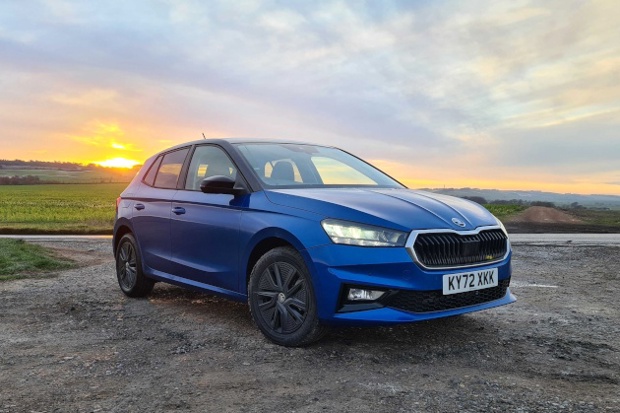
Specifications: Skoda Fabia 1.0 TSI 110 DSG Colour Edition
- Run by: Lawrence Allan since November 2022
- Price when new: £20,590 (£21,960 including options)
- Engine: 1.0-litre 3cyl turbo petrol
- Power: 110PS
- Torque: 200Nm
- Claimed economy: 49.4-50.9mpg
- CO2 emissions: 128g/km
- Insurance group: 13
- Report 1: Is this the best small car?
- Report 2: What is the Colour Edition?
- Report 3: What does 'Simply Clever' mean?
- Report 4: Is the manual or DSG automatic better?
- Report 5: We’re not getting closure
- Report 6: Is this all the car you ever need?
- Report 7: Wheel trims or alloys?
- Report 8: Testing touchscreen times
- Report 9: We say goodbye to a great small car
Report 1: Is this the best small car?
We take delivery of Skoda's do-all small car, the latest generation Skoda Fabia. Having been a sales hit for two decades now, is the latest model the greatest yet? We'll find out over the next six months.
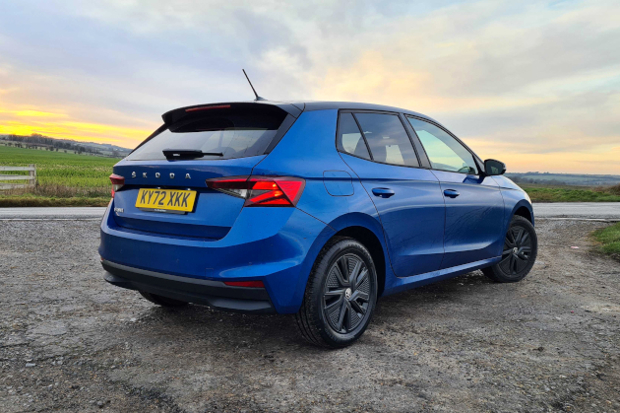
Date: 1 December 2022 | Current mileage: 332 miles | Claimed economy: 49.4-50.9mpg | Actual economy: 46.9mpg
Swapping into our Skoda Karoq and running it for its remaining few months was enough to remind me just how capable Skoda as at building honest, straightforward and yet extremely satisfying transport for the masses. But I wanted to test that mission statement to the limit with the brand's smallest and cheapest offering.
Enter the new Skoda Fabia. Yep, the brilliant Citigo is no more, consigned to the history books along its SEAT Mii sibling, although the Volkswagen Up is still on sale for now. With tougher-than-ever safety, emissions and technology standards making money out of a cheap city car in Europe is proving nigh-on impossible.
The next class above is still clinging on. How much longer it will remains to be seen with Ford deciding to pull the huge-selling Fiesta out of the market next year. So this Skoda Fabia is here to remind us what we might be missing in a few years time.
Our car comes fitted with the second most powerful engine in the Fabia range; the venerable 1.0-litre three-cylinder turbo petrol engine with 110PS (up from the lesser 95PS version). If that isn't enough for you Skoda will sell you the Fabia Monte Carlo, which puts out 150PS courtesy of a 1.5-litre four-cylinder unit.
It's plenty enough for us, with 0-62mph coming up in ten seconds dead and a 125mph top speed. Interestingly ours comes with the seven-speed DSG automatic rather than the standard six-speed manual (lesser Fabia engines get a five-speed manual). We'll delve more deeply into this gearbox in later reports as we're not totally convinced it's the one to go for.
This Colour Edition model sits one rung up from entry-level SE Comfort trim, offering a few key equipment upgrades but also more of a style focus with details like black-painted alloy wheels and a contrasting black roof. Again, we'll do a more in-depth report on this spec in due course because there's one or two key pieces of equipment we'd like to see.
At nearly £22,000 as tested this Fabia is proof that bargains in the new car world are few and far between. However first impressions are positive with the car proving comfortable, spacious and great for zipping about town. Delivered with just 78 miles on the clock the engine is still loosening up, so we'd hope to see an improvement in the miles-per-gallon as the miles rack up through winter.
Report 2: What is the Colour Edition?
We delve more deeply into our Skoda Fabia's spec and equipment list to see if you're better off choosing more wisely.

Date: 21 December 2022 | Current mileage: 894 miles | Claimed economy: 49.4-50.9mpg | Actual economy: 44.2mpg
It's often the case that new cars have a baffling array of trim levels and special editions to choose from. But with car companies trimming the fat and simplifying their ranges things are changing. In this new-gen Skoda Fabia in the UK there are just four trim levels to choose from, for example, while the old model had twice that at certain points.
But have we chosen correctly with our Skoda Fabia Colour Edition? Sitting above entry-level SE Comfort (gone is the basic S model because nobody really bought it), the Colour Edition is priced at about £1000 less than SE L trim, aiming at a more youthful audience.
To that end you get - of course - more colour. Or rather less colour, because instead of body colour all-round Skoda paints the roof and A pillars, door mirrors and wheels in contrasting black. I suppose it does make it look more sporty, but I'm not a big fan of the 16-inch small-spoked alloys that look a bit like black wheel trims until you get close.
Further standard kit in the Colour Edition includes the 10.25-inch Virtual Cockpit instrument display, the mid-level eight-inch 'Bolero' touchscreen and privacy glass. You already get things like LED headlights, rear parking sensors and Bluetooth in SE Comfort, but in 'my' car I'm grateful for the upgraded stereo with its extra pair of speakers. That touchscreen in the base variant looks pretty tiny, too.
Other than metallic paint and floor mats our car also comes with the Park and Go Package Basic, which for £665 brings all-round parking sensors, a rear-view camera and (oddly) LED rear lights. Is that essential? Not really, when the Fabia is a compact and easy to park small car, but it is a bonus.
I'd definitely rather have cruise control, which is an odd omission on the lower trim levels given most small cars get it across the range. Using the speed limiter instead means you don't have to lock your right ankle in one position for a long drive, but I'd prefer to remove my foot from the throttle entirely. Adaptive cruise is a £485 option across the range, but you only get normal cruise on the two top trims. Oh, and Skoda even charges you £100 to fit rear disc brakes. Stingy much?
Having said that the option packs are simple and affordable. £840 gets you the Winter Package, for example, with a heated wheel, heated front seats, a heated windscreen, dual-zone climate control, cruise control, an auto-dimming rear-view mirror and even heated washer nozzles, plus some other little bits. That's good value and probably the one pack we'd go for.
Report 3: What does 'Simply Clever' mean?
We look at some of the oft-forgotten features that have made our Skoda Fabia easier to live with over the winter months.

Date: 15 January 2023 | Current mileage: 1582 miles | Claimed economy: 49.4-50.9mpg | Actual economy: 43.8mpg
Often when you're looking at buying a new car and checking out standard features you'll only focus on the key equipment. Things like sat-nav, cruise control, automatic braking and suchlike. But sometimes it's the little details that can make a car, and for years Skoda has been offering little touches to make living with its models easier.
Called 'Simply Clever', all of Skoda's models get neat little touches (many you wouldn't notice at first glance) to improve mundane tasks. Even its cheapest model, our Fabia, gets a number of these as standard. Things like a little clear plastic holder on the windscreen for parking tickets, a cupholder that grabs bottles to let you open them with one hand and neatly integrated storage compartments for odds and ends.
I wanted to highlight three features that have proved very useful in the winter months. The first is the integrated ice scraper (pictured above) that sits in a handy holder in the fuel filler cap. We'd rather have the Winter Pack optioned with its heated windscreen, but it's a handy free substitute.
Also invaluable is the umbrella built into its own little cubby inside the door. Hidden away neatly, it's been a godsend for those times I've emerged from the car in torrential rain and realised I've forgotten my own umbrella. Also, it makes you feel as if you're driving a cut-price Rolls-Royce. Sort of...
And finally, special mention to the screenwash filler cap which has a built-in funnel to stop you spilling it everywhere - very useful when you're topping it up regularly on salt-covered roads. None of these features are high-tech or expensive, but they're little touches that could have easily been deleted by Skoda's accountants and show that attention-to-detail is alive and well.
There's two further 'Simply Clever' option packs that add a wealth of storage options and features to make the most of the space in the boot and back seats. We'd highly recommend looking at those if you've got a family - you might realise you don't need that SUV after all.
Report 4: Is the manual or DSG automatic better?
The automatic gearbox in our Fabia makes sense in city traffic, but is it actually the one we’d choose?
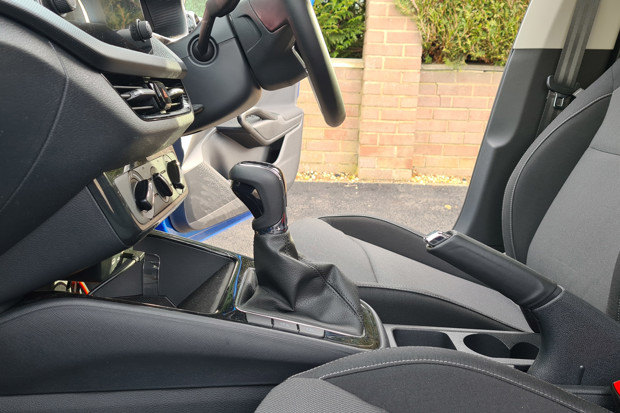
Date: 30 January 2023 | Current mileage: 1728 miles | Claimed economy: 49.4-50.9mpg | Actual economy: 43.9mpg
Manual vs automatic: it’s the age-old battle for new car buyers. But it’s becoming a foregone conclusion - autos overtook manuals as the default choice for UK new car buyers in 2020, and with fewer self-shifting options than ever (alongside growing demand for electric cars and hybrids) that’ll continue to be the case.
Happily, for those who like to slot home a shift themselves, the Skoda Fabia is available in both forms. Our 110PS car can be had with a six-speed manual or the seven-speed DSG auto. We’ve got the latter, and it’s a bit of a bone of contention.
On the plus side it’s an absolute doddle to drive. For the non-enthusiasts (and that’s the vast majority of car owners, remember) removing the faff of clutch biting points and stirring a gearstick makes those wearisome cross-town slogs more bearable. A seventh gear also keeps the engine in its power band more easily.
I’m afraid that’s where the positives end for us, though. The problems start on the spec sheet, where you find the Skoda Fabia DSG is both £1000 more expensive to buy than the manual and nearly 10% less efficient in official tests (54.9 plays 50.2mpg).
We’re also not huge fans of it out on the open road. Clearly stung by criticism of the old DSG gearbox’s jerkiness at low speeds Skoda has dulled the speed of the changes. While that makes it easier to park, it also means the whip-crack dual-clutch shifts we’re used to are now pretty glacial, feeling slower than a modern torque converter auto. And, despite this, you can still catch it out at junctions.
More irksome still is the auto’s constant insistence of picking the highest gear possible - it’ll slot you into sixth at just over 30mph, for example, and change up below 2000rpm under normal acceleration. With a three-cylinder turbo engine this means more vibration through the controls than we’d like, plus a yawning pause when you need a burst of acceleration but the turbo is quite clearly asleep.
You can get round this by selecting S mode on the shifter, but this keeps revs too high when you’re just pootling about. Pulling the lever over into manual mode also solves it, but with no gearshift paddles on the wheel you’re pushing or pulling the lever for every shift. And that defeats the point of choosing the auto, surely? In short: if you drive across a city at rush hour every day, get the DSG. For everyone else the manual is a better bet.
Report 5: We’re not getting closure
Our Fabia’s fuss-free approach makes it easy to live with, but there’s one gripe that’s a bit of an open and shut case.

Date: 10 February 2023 | Current mileage: 1991 miles | Claimed economy: 49.4-50.9mpg | Actual economy: 44.1mpg
I recently moved into a new flat, and while a big (and brilliant) VW Crafter tackled the big ticket items, our Skoda Fabia was regularly ferrying smaller stuff back and forth between homes old and new. But this highlighted the first real issue we’ve had with this highly competent small car: the bootlid.
“The sodding boot doesn’t close” cried my Dad who’d borrowed the Fabia to move some kitchen items to the new place. He’d driven 18 miles with the car’s digital dash flashing up that the boot wasn’t shut, and the interior lights staying on. Despite stopping twice to close it it never properly latched.
I’d already experienced this once or twice before, but put it down to me being too delicate. But it still took me two attempts to get it shut with a less-than-delicate slam sealing the deal. My Dad had been too gentle for fear of breaking the back window, it seems. Imagine elderly or disabled owners trying to get their shopping home, though…
We’re convinced this may be a simple case of the bootlid being slightly out of alignment on its hinges, but we’re not sure - and it’s not something we’ve experienced on other Skodas. It’s hardly the end of the world, but when you’re opening and closing the boot twenty times in a day it can really grate. At least Skoda gives you a protruding rubber handle on the inner bootlid to give it a purposeful pull without getting your fingers mucky on the outside.
It speaks volumes that (other than the aforementioned gearbox gripe) this is the only real annoyance in what is otherwise a straightforward and competent car. Its logical, well-made cabin, composed driving experience, ability to easily do over 50mpg on a run and surprising practicality means it punches above its weight.
Report 6: Is this all the car you ever need?
It might not be a large estate or SUV, but don't overlook that humble Fabia if you're after a great-value family car.
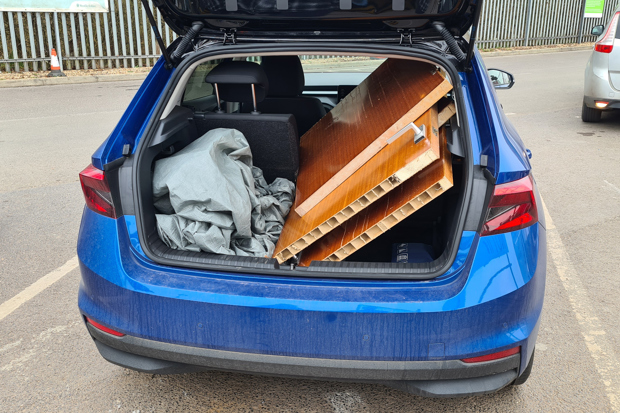
Date: 6 March 2023 | Current mileage: 2592 miles | Claimed economy: 49.4-50.9mpg | Actual economy: 44.0mpg
The phrase ‘all the car you ever need’ is one you’ll often hear us motoring journalists using to describe big family estates or SUVs. But the growth in size and capability of small cars means we reckon our Skoda Fabia genuinely qualifies for the tag.
Alright, so if you’ve got three kids, luggage and two Labradors to squeeze in for a family holiday, then there are clearly better options out there. But for those who’ve yet to expand their family quite so generously the outwardly humble Fabia is a lot more of an all-rounder than you might expect.
Sticking with the space theme, it’s swallowed up four six-plus-footers for hour-long journeys on more than one occasion now with no complaints. Rear legroom in particular makes the Ford Fiesta seem like a car from the class below. Stats show the average UK family now has 1.7 children (not literally) plus a dog, and as long as that dog is something like a Jack Russell rather than a Great Dane the Skoda Fabia could genuinely serve as your main family car.
And then there’s the boot; nothing short of a Honda Jazz in this class of car can lug more loads. My recent flat purchase meant some renovations such as changing the interior doors, and although the hideous old wood/cardboard mix doors couldn’t be safely transported to the tip intact a quick attack with the saw meant they all crammed in – with room to spare for a rear passenger thanks to the split/folding seats. It’s only a shame that Skoda no longer makes the Fabia Estate, which may well have swallowed the doors fully intact.
It's been a rare occurrence that I’ve been dying to use something bigger or plusher. Even the typically miserable South England motorway slogs are dispatched in comfort and frugality. Sure, there’s a touch more road noise than in a larger, more insulated family car, but that’s really the only difference. Think you need to spend big to get a multi-purpose set of wheels? Think again.
Report 7: Wheel trims or alloys?
Lurking underneath our Fabia's wheel trims are actually some pretty decent alloy wheels. What's the point you're probably wondering?

Date: 20 March 2023 | Current mileage: 2789 miles | Claimed economy: 49.4-50.9mpg | Actual economy: 43.9mpg
For a while we thought that hubcaps (or wheel trims) were becoming a thing of the past, only reserved for the most basic versions of small cars. But they’re coming back in a slightly different form.
Like a number of electric cars including some Teslas and the Skoda Enyaq, our Skoda Fabia Colour Edition comes with alloys hidden behind clip-on wheel covers. Why? Well they are meant to improve the car’s aerodynamics by creating a flat surface, improving airflow across the wheels at high speeds.
But do they look good? I must confess I’m not a huge fan as I mentioned in an earlier report – the combination of black wheels and black covers make it look like it’s on a set of steelies. I’d seen a lot of Tesla owners removing theirs, so I thought I’d have a go too.
It turns out the covers pop off quite easily. All you need is a flathead screwdriver to lightly lever the middle of the cover out and then the whole thing is off (don’t lever from the outer edge as you’ll probably break them).
The result? Well, there’s a decent set of ten-spoke black alloys underneath that look quite nice. The issue is that you’re missing the Skoda logo on the centre caps, with the wheel hub actually exposed (and already holding a bit of surface rust as the image shows).
The wheel nuts are very visible too, as are the rear brake drums – as we’ve mentioned before rear discs are a £100 option. That’s probably a box we’d tick just for the look alone if you planned to run with the wheel covers off, as we will be for a bit. Will it make any difference to the MPG? I suspect it’ll be very difficult to tell…
Report 8: Testing touchscreen times
Our Skoda Fabia has been a reliable constant in life, but an irritating issue has now reared its head.

Date: 10 April 2023 | Current mileage: 3290 | Claimed economy: 49.4-50.9mpg | Actual economy: 44.1mpg
If you keep abreast of new car developments you may have heard that the new-age Volkswagen Group touchscreen infotainment systems have come in for a bit of a pasting. Not just from car writers like us, but from owners who find the systems glitchy and user unfriendly.
Indeed, I had some complaints with the Volkswagen Golf I ran previously. So I was pleased to see that the Skoda Fabia retains an older, tried-and-tested touchscreen design. The menus are simple, the shortcut buttons along the sides of the screen are helpful and - praise be! - there’s a proper physical volume dial too.
So you can imagine my disdain when I started the Fabia up early this year to see a black screen of death. It normally boots up instantly, and jabbing all the buttons didn’t elicit any signs of life. Hmm.
Happily, ten minutes later it sprung into life, still black but with the screen backlit, with a minute of nothing before a random message about data protection popped up. Once cleared all was well and I was back listening to my outdated Spotify playlist.
It seemed to be an isolated issue, but a couple of weeks later the same thing happened again. And then again after the same period. I’ve no idea what triggers it, but I’m thankful it’s not more frequent. There’s no new software update available in the system itself, so perhaps a visit to the dealer for a diagnosis is in order.
In a seemingly unrelated issue Android Auto has now decided to give up the ghost. It normally links to my phone wirelessly, but even connecting a USB-C cable and manually searching for the phone doesn’t work. In all honesty I’m not sure I can blame the car for this as my well-worn Samsung Galaxy S20 may be at fault, so I’ll need to test it with another phone to be sure.
Both are irritating gripes in what has been an otherwise pleasantly pain-free few thousand miles in the extremely competent Fabia. Let's see if they can be resolved.
Report 9: We say goodbye to a great small car
Lawrence is sad to bid farewell to one of the most affordable little cars on sale.
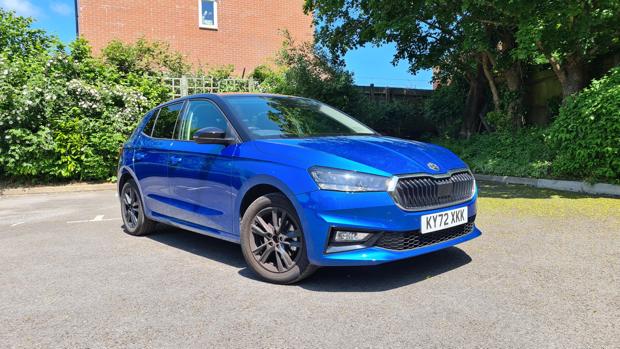
Date: 25 May 2023 | Current mileage: 4482 miles | Claimed economy: 49.4-50.9mpg | Actual economy: 44.9mpg
Our time with the Skoda Fabia has come to an end, and I must admit it’ll be sorely missed. That’s something car writers would usually feel about giving up some adrenaline-dosing sports car or bells-and-whistles luxury limo. But while the rational, unassuming Fabia never tugged at the heartstrings, it fulfilled its purpose for me perfectly.
My personal car is a Jaguar S-Type with a 4.2-litre V8 engine. I love its burbling soundtrack and sense of occasion, but it’s best enjoyed as a weekend treat because in daily driving it starts to frustrate. For starters you’re looking at 25mpg or so from longer runs, and sub-20mpg in mixed slower driving. But it’s also amazing how such a big, difficult to park car and have such little space inside. Oh, and being both old and British, you might as well permanently leave your credit card at the local Jag specialist…
This is why I spent a good deal more time in the Fabia, completing the sort of mundane, traffic-heavy journeys that happen all too often in the South of England. Managing double the MPG of the Jaguar on long runs, it settled at around 45mpg with a fair bit of town work thrown in. That town work was a doddle thanks to it being so easy to park and thread through traffic, while the automatic gearbox took the sting out of snarled-up commutes – even if overall we’d have preferred the manual. The engine also punches above its weight, and stays refined even when pushed.
There’s precious little compromise to make for its size, either, as I regularly drove four up with larger passengers barely uttering a complaint. The boot swallowed up tip runs, holiday luggage and even a hefty storage heater like few other small cars, and there’s a general air of long-lasting quality from the cabin too. Granted, a Ford Fiesta will give you a bigger grin on twisty tarmac. But the Ford doesn’t offer the fit-and-finish and practicality of the Fabia.
That doesn’t mean it’s been faultless. The odd infotainment glitch - plus the weirdly difficult-to-close boot lid – took the sheen off ever so slightly, but it never actually bothered me enough to go and visit a dealer to resolve things. The only handover issue was those wheel trims: I gloated about how easy they were to remove in an earlier report, but I couldn’t get them back on easily before collection day without feeling like I’d break something. Sorry Skoda, they’re in the boot!
There will be many car enthusiasts who dislike humble, purely sensible cars such as these, preferring a car to turn every journey into an event. But I reckon if you’re lucky enough to have one ‘event’ car for when you’re in the mood, something like the Fabia is perfect for the many times you just want to get a journey over and done with. Dare we say it, is this the best small car on sale? I’d say so.
